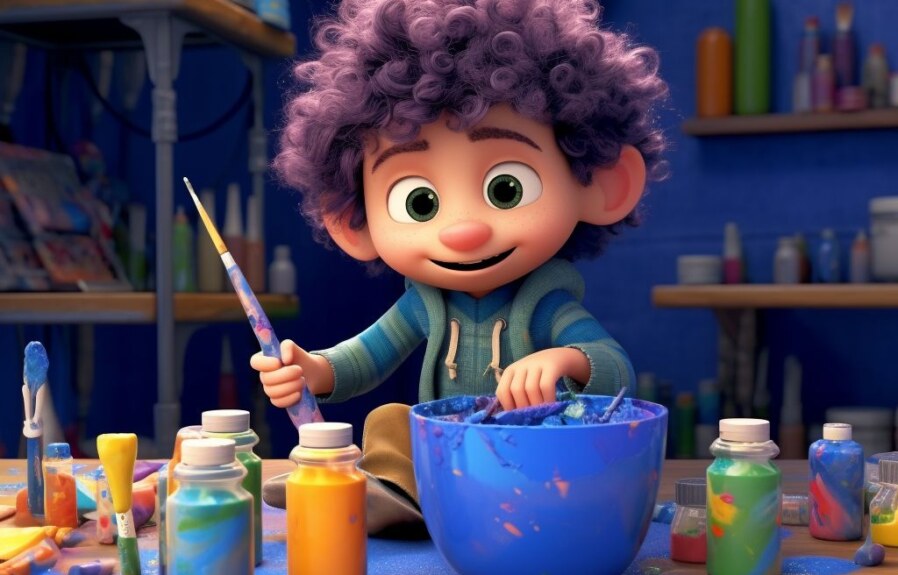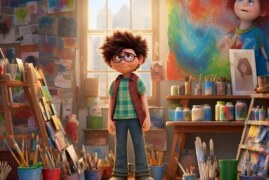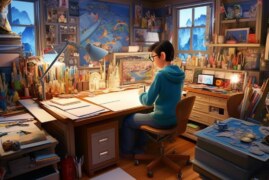Dark blue is a classic color that has been widely used in art and design. It’s a shade that exudes confidence, depth, and sophistication. From paintings to interiors and fashion, dark blue has made its mark in many creative fields. However, not all blues are created equal, and getting the perfect shade of dark blue may seem like a daunting task. Fear not, for we have the answers on how to make dark blue. In this article, we’ll explore the theory and practice of color mixing, and provide you with tips and tricks on how to achieve the perfect dark blue hue. Whether you’re an artist, designer or simply someone who loves to experiment with color, read on to discover the secrets of making dark blue.
1. Understanding the Color Theory: The Basics of Creating Dark Blue Shade
Before diving into the world of mixing pigments and exploring natural dyes, it’s important to understand the basics of color theory. Dark blue is a hue that can be created by either mixing other colors or using natural materials that produce blue pigments. To create the perfect shade of dark blue, you need to have a basic understanding of color theory, which involves the relationships between colors and how they interact with each other.
When we talk about color, we are talking about the visible light spectrum, which includes red, orange, yellow, green, blue, indigo, and violet. Colors can be warm or cool, bright or dull, light or dark, and complementary or analogous. These characteristics of color play an important role in how we perceive and mix different colors.
Creating a dark blue shade involves starting with a blue base and adding either black or a complementary color to darken it. Blue is a primary color, which means it cannot be made by mixing any other colors together. However, by adding different amounts of white, black, or other colors, you can create a wide range of blue shades from light to dark.
To create a dark blue shade, start with a blue paint or pigment and add small amounts of either black or a complementary color such as orange or red. This will create a darker shade of blue. It’s essential to test your mixture on a small scale before using it on your artwork, as different pigments and mediums can affect the outcome. Don’t be afraid to experiment with different ratios and combinations until you find the perfect dark blue shade to bring your artwork to life.
2. Mixing Pigments: Finding the Right Combination for Making Dark Blue
One of the most common ways to create dark blue is by mixing different pigments. Pigments are colored substances that can be combined to create new hues. However, before mixing pigments, it is essential to understand the color theory and how different colors can affect the outcome.
To make dark blue, you will need three primary colors: blue, red, and yellow. The primary colors are the base colors that cannot be made from any other colors. Mix equal parts of blue and red pigment to make purple. Then, gradually add more blue pigment to the mix until you reach the desired shade of dark blue.
It is essential to use high-quality pigments as low-quality ones can affect the final color and texture. Pigments come in various forms such as dry pigments, liquid pigments, and paste pigments. Dry pigments are the most common type and can be mixed with various mediums such as water, oil or acrylic.
Tips for Mixing Pigments
- Begin with the lightest color – Start with the lightest color and gradually add darker hues to avoid overdoing it.
- Use a palette knife or a toothpick – Use either of these tools, a palette knife or a toothpick, to blend the colors, mix the pigments thoroughly, and avoid over-mixing, which can result in dull colors.
- Keep a record of the ratios – If you get the perfect dark blue shade, record the ratios and proceed to create larger amounts if needed.
Once you have mixed the pigments, test the color on a separate piece of paper to ensure that it matches the desired hue. If it’s still not the perfect shade, adjust it by adding more pigment in small increments.
Creating the perfect dark blue shade through pigment mixing can take some practice, as it depends on your color perception and art style. Therefore, experiment with various pigments and explore new combinations to create unique and beautiful works of art.
3. Exploring Natural Dyes: Producing Dark Blue Using Natural Materials
In this section, we will delve into the world of natural dyes and learn how to create a dark blue shade using materials found in nature. Natural dyes offer a sustainable and eco-friendly alternative to synthetic pigments while producing unique and complex colors.
Indigo:
One of the most popular natural dyes used to produce dark blue is Indigo. This plant-based dye has been used for centuries in various cultures around the world. The leaves of the Indigo plant are harvested and dried, then soaked in water to create a blue dye. To achieve a dark blue shade, the dye is fermented over several days or weeks, allowing the dye to fully develop. The final dye bath can vary in intensity, producing shades ranging from light blue to deep navy.
Woad:
Another natural dye that can produce a dark blue shade is woad. Woad is a plant that is native to Europe and was historically used to dye clothing. The leaves of the woad plant are harvested and processed to create a blue pigment. To produce a dark blue shade, the pigment is mixed with an earthy material such as clay, which increases the dye’s color concentration.
Using natural dyes to produce a dark blue shade can be a fun and rewarding process. Experimenting with different materials and techniques can produce varying shades and hues of blue while reducing the impact on the environment. Keep in mind that natural dyes require additional preparation time and may have limited color-fastness, meaning the color may fade over time. Overall, natural dyes offer a unique and sustainable approach to producing dark blue in art and design.
4. Choosing the Right Medium: Using Watercolor, Acrylic, or Oil Paint for Dark Blue
In choosing the right medium for creating dark blue, it is important to consider factors such as pigmentation strength, application technique, and drying time. Watercolor, acrylic, and oil paints are some of the most commonly used mediums in creating art and each one has its own unique characteristics that make them suitable for different styles and techniques.
Watercolor paint: Watercolor is a translucent medium that is known for producing delicate washes and subtle blends. It is a popular medium among artists who prefer a more fluid and spontaneous approach in their art. When using watercolor to create dark blue, it is important to use a strong pigmented blue color such as ultramarine blue and layer it in gradually to achieve the desired depth of color. Watercolor is best used on paper or other porous surfaces.
Acrylic paint: Acrylic paint is a versatile medium that can be used for both thin washes and thick, impasto applications. Unlike watercolor, acrylic paint is opaque and dries quickly, allowing for more layers to be added without having to wait for the paint to dry. To create dark blue with acrylic paint, a deep blue pigment such as phthalo blue or cobalt blue can be mixed with a small amount of black or brown to create a rich, moody hue. Acrylic paint can be used on a variety of surfaces and can be thinned with water or medium to achieve different effects.
Oil paint: Oil paint is a classic medium that has been used by artists for centuries. It offers a range of textures and techniques, from thin washes to thick impasto applications. Oil paint is a slow-drying medium that allows for more time to blend and layer colors. To create dark blue with oil paint, ultramarine blue can be mixed with a small amount of black or burnt umber to create a rich, intense color. Oil paint is best used on canvas or other rigid surfaces.
When choosing a medium for creating dark blue, it is important to consider the desired effect and style of the artwork, as well as the artist’s personal preference and experience. Experimenting with different mediums can lead to exciting new discoveries and techniques in creating art.
5. Color Complementarity: Enhancing Dark Blue with Complementary Colors
Enhancing Dark Blue with the Magic of Complementary Colors
Complementary colors, also known as opposite colors, are hues that are positioned across from each other on the color wheel. When used together, they create a strong contrast and visual interest. In the case of dark blue, its complement is orange, which can add warmth and vibrancy to a painting or design. Here are some tips for using complementary colors to enhance dark blue:
1. Experiment with Different Shades of Orange
Orange comes in various shades, from bright, citrusy tones to deeper hues like rust and burnt orange. When paired with dark blue, each shade can create a different effect. For example, a light peach or coral can create a soft, feminine look, while a rusty orange can add a rustic, earthy feel. Play around with different shades and see what works best with your design.
2. Use Complementary Colors Sparingly
While complementary colors can enhance a design, too much of them can overpower the main color and create visual chaos. To avoid this, use complementary colors sparingly and strategically. Consider using orange as an accent color, rather than a dominant shade, and use it to highlight specific areas of your design.
3. Incorporate Other Complementary Colors
Complementary colors don’t have to be limited to just orange. Dark blue can also be enhanced by its other complements, such as yellow, which can add a sunny, cheerful feel or purple, which can bring a regal, luxurious touch. Using multiple complementary colors can create a dynamic, eye-catching design.
Overall, using complementary colors is a great way to enhance dark blue and create a visually compelling design. By experimenting with different shades and using them strategically, you can add a new dimension and depth to your art and design projects.
6. Light and Shadow: Adding Depth to Dark Blue Through Shading Techniques
Adding light and shadow to dark blue can give it depth and dimension, making it appear more dynamic and interesting. It also offers an opportunity to create a full range of colors and values within the blue palette.
Techniques for Adding Light and Shadow
One way to add depth to dark blue is to incorporate shading techniques. The simplest approach is to add white or a lighter shade of blue to the areas of the painting where light is hitting. Conversely, incorporating a darker shade of blue or black into areas where the light cannot reach adds shadow and depth.
Another way to add depth to dark blue is to incorporate gradients, which involves blending different shades of blue or other colors together. This technique creates a softer, more natural transition between the various areas of the painting, and can create the appearance of distance or depth.
Tips for Successful Shading Techniques
To ensure the shading techniques look seamless and natural, it is essential to use multiple layers of paint. Avoid jumping into the darkest or lightest pigments too quickly, and slowly build color and tones. The more layers, the more dimensional the final work will appear. It is essential to take the time to experiment with various shades and techniques to understand what works best for the specific project.
In conclusion, adding light and shadow to dark blue can significantly enhance it, making it appear more realistic and three-dimensional. Techniques such as grading and using layering/buiding color are useful techniques to master when creating a range of hues and values.
People Also Ask
What colors make dark blue?
To make dark blue, you can mix ultramarine blue with a touch of black paint. Alternatively, you can mix equal parts of Prussian blue and Burnt Umber.
How do you make navy blue with acrylic paint?
To make navy blue with acrylic paint, mix different shades of blue such as ultramarine, Prussian, and pthalo blue with a touch of black paint. Keep mixing until your shade reaches your desired tone.
Can you make dark blue with primary colors?
Yes, you can mix primary colors to make dark blue by mixing ultramarine blue and crimson red together. Alternatively, you can mix equal parts of blue and green paint.
What colors make royal blue?
To make royal blue, mix ultramarine blue and a touch of purple paint with a bit of white to make it brighter. Alternatively, you can combine potter’s pink with ultramarine blue to make a royal blue color.
How do you make dark navy blue icing?
To create dark navy blue icing, you can use a mixture of blue, black and violet food coloring. First, mix in small amounts of blue food coloring and add a dot of black food coloring. Finally, add a small amount of violet coloring until you get the desired shade of dark navy blue.
Conclusion
There are various ways to make dark blue color using different types of paints, including ultramarine, Prussian, and pthalo blue, as well as by mixing primary colors. Whether you are creating art projects or a specific shade of icing, with a little creativity and experimentation, you can create the perfect shade of dark blue for any project.



